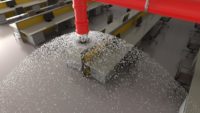Preserving history means not only safeguarding artifacts from the ravages of time but also protecting them from fire damage and related risks.
The Museum of the American Revolution in Philadelphia, which houses relics from the defining period in the country’s history, faced serious challenges when it took possession of Gen.George Washington’s original sleeping and office tent. The tent was a boon to the museum, but its fragile condition raised concerns about how it could be safely protected once it was erected.
Protecting the tent once it was set up in the museum posed a monumental challenge. The tent would be on display in an area of the museum that the city fire safety code states must be protected with a sprinkler system, but its linen and wool construction would be irreparably damaged if a sprinkler system was discharged.
To ensure the safety of the museum and the display, museum management needed to find a better solution.
Understanding the parameters
The tent that served as George Washington’s headquarters is believed to have been made in Reading, Pennsylvania, in the early part of 1778. When the museum took ownership of the tent in 2015, it began the complex process of conserving and restoring the tent in preparation for creating its Valley Forge exhibit. The reconstruction of the tent would draw on the expertise of structural engineers, historians, tailors, conservationists and curators.
One of the challenges of displaying the tent was to make it appear as if it were pitched in the field. This had to be accomplished without putting tension on the physical structure that would induce stress in the centuries-old fabric and potentially cause damage.
The fragile state of the material meant interaction with the tent had to be extremely delicate, and that led to innovative construction solutions such as ropes secured by rare earth magnets that do not stress the delicate material. Because even air turbulence could potentially damage the fabric, curators determined that once the tent was set up in a protected area of the museum auditorium, it would remain undisturbed to eliminate the possibility of damage.
Selecting the system
The City of Philadelphia has strict variances regarding fire safety systems and requires sprinklers to be installed to cover 100% of the floor area in all public buildings. Because sprinklers were not an option for protecting George Washington’s tent, museum management began to investigate alternative fire protection systems.
In the search for an ideal system, they would have to find a way to not only protect the exhibit from fire but ensure no damage would be incurred in the aftermath of a discharge. The fire protection system selected to protect the delicate tent also would have to be aesthetically pleasing — no components of the installed system should be visible to visitors viewing the tent from within the theater.
The team evaluated multiple water mist, hypoxic and clean agent systems, among others, without finding an appropriate solution. Then, they discovered the hybrid Victaulic Vortex system.
How the Victaulic Vortex system works
The Victaulic Vortex hybrid fire extinguishing system, which is based on cyclonic distribution of nitrogen and potable or distilled water, consists of stored nitrogen cylinders, a captive water supply and overhead emitters that are installed in the hazard area.
The foundation of this design is a vortex emitter that uses patented technology to distribute a homogeneous suspension of nitrogen and water molecules that are only 10 microns in size. This maximizes the system’s ability to rapidly extinguish fires using only a quarter gallon of water per emitter per minute to protect a Class ‘A’ fire hazard. For the installation in the museum, the system would disperse 13.7 gallons over 2.5 minutes utilizing 21 emitters.
The tiny droplets form a non-candescent cloud that absorbs heat and reduces oxygen to extinguish a fire. The amount of nitrogen required for the system is determined by the elevation and enclosure volume of the area being serviced, in this case 25,125 cubic feet. The design allows the system to be effective in naturally ventilated spaces, which means there is no need for an air-tight room, and unlike other systems that reduce oxygen to unsafe levels for humans, the Victaulic Vortex system is designed to extinguish fires at an oxygen level around 13% over a 3-minute discharge time.
A twin piping network and emitters discharge the suspension of water and nitrogen into the hazard area. Because of the nature of distribution, there is nearly zero surface wetting, which means there is minimal cleanup required and little danger of causing damage to the fragile fabric of the tent. Another advantage of this system is that the nitrogen cylinders can be recharged quickly on site after they are discharged, so there is very little time during which the system is offline.
Selection and installation
This hybrid system ticked all the boxes, but the museum management wanted to see it in action before making a decision. Curators witnessed a test of the Victaulic Vortex system at the Victaulic facility in Easton, Pennsylvania, to evaluate its effectiveness and requested additional tests to provide confidence in the system’s ability to extinguish a fire without causing damage to the tent.
Using different types of materials to simulate the tent’s linen and wool fibers, test discharges were carried out, with technicians weighing the fabrics before and after to record the amount of water absorbed.
An additional live fire test using linen demonstrated not only that the fabric would be undamaged following a discharge but that the vortex system could suppress the fire without creating turbulence that could cause damage by disturbing the delicate cloth.
System flexibility delivered another important advantage, allowing the emitters to be angled to the pitch of the tent to permit a gentle discharge and enabling placement that positioned them out of sight of museum visitors.
With the decision made to install the Victaulic Vortex system, forms were submitted to the city to secure a waiver that would allow the project to move forward.
When the waiver was issued, a two-person crew set up the system in approximately 160 hours, installing 25 nitro-gen cylinders and a 30-gallon water tank in the basement of the building and the discharge system in the second-floor auditorium approximately 220 feet away. Using a lift to access the 18-foot ceiling, technicians installed the emitters to allow complete coverage of the room.
Technology at work
The usual placement of the panel that controls the nitrogen and water sources posed a challenge for this installation. Hybrid fire extinguishing systems require a 30-second maximum delivery time for the hybrid media to reach the protected enclosure.
Initially, the total equivalent run of piping from the water source in the basement to the protected enclosure was more than 480 feet, which jeopardized the ability to deliver the water and hybrid media within the required time.
The flexibility of the Victaulic Vortex system equipment enabled a modification in the form of a second “zone” panel. Located directly under the room housing the tent, the zone panel controls pressurized water closer to the system, which decreases delivery time from 1 minute to only 15 seconds and in the process reduces the amount of equivalent piping from 600 feet to 125 feet.
Once the system was installed, Suppression Systems (SSI) tested and commissioned the system. In controlled conditions, SSI engineers released canned smoke in the auditorium to make sure the detectors and alarms would activate in the case of a fire. A second test entailed pressurizing the manifold of the vortex system then shutting the tanks off and using the zone panel to release nitrogen into the emitter, producing a small discharged to ensure the system was working properly.
With the successful conclusion of the tests, the Victaulic Vortex system was certified by SSI and placed into service.
The Victaulic hybrid fire extinguishing system enabled the inclusion of George Washington’s tent in the Museum of the American Revolution’s collection of nearly 3,000 Revolutionary-era artifacts and is delivering protection for this valuable exhibit without compromising safety.
The flexibility and performance of the Victaulic Vortex hybrid fire extinguishing system prove its value in a particularly challenging installation. It shows how the perception of fire safety systems is changing and opens the door for an even broader range of applications.



